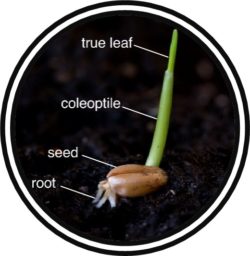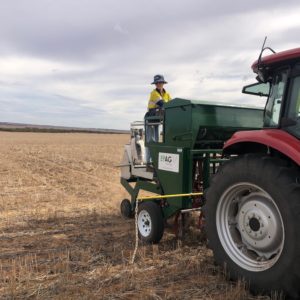New long coleoptile wheat trialled on EP for first time
Summary
- Novel ‘long coleoptile’ wheat varieties allows a seeding depth of 120 mm.
- Deeper sowing gives access to subsoil moisture for germination without having to wait for an autumn break.
- Trials have begun to assess the potential of long coleoptiles in our farming systems.
- Pressures of a changing climate may require further research into alternative seeding programs such as deeper sowing.
What is a coleoptile?

Source: Plants: the green starfish of the world | by Patrice A Salomé | Plant Cell Extracts | Medium
A coleoptile is a hollow organ that extends from the seed to the soil surface, acting as a protective sheath that covers the first shoot during germination. The longer a coleoptile is, the deeper a seed can be planted. Researchers found that increasing the coleoptile length of wheat allows successful germination of depths up to 120 mm.
Where have long coleoptile wheats come from?
In a nutshell, scientists extended the coleoptile length in the modern varieties we farm today by using traits from old school wheat varieties. Breeders were specifically interested in wheat that was cultivated by farmers prior to the green revolution in the 60’s. These varieties were taller in general and most importantly, had coleoptiles that were 40% longer. From these tall wheats, an ‘alternative dwarfing gene’ was identified by its ability to extend the coleoptile and still maintain the high yield and performance of modern varieties. Breeders are now selecting new cultivars with this dwarfing gene and around 10% of our current wheat varieties show this longer coleoptile to some degree.
*Note this crossbreeding process is how we find new traits in all our modern wheat varieties today and is not a genetically modified organism (GMO).
Why would we sow our wheat deeper?
Sowing at depths of up to 120 mm allows access to subsoil moisture that may be stored from earlier rainfall events over summer*. Deeper sowing may be another option to germinate our crops, rather than relying solely on an autumn break rain. This year has been an example of an uneasy start to the season, where farmers may be interested in sowing deeper and earlier in order to:
- Accommodate large seeding programs
- Enhance early vigour to out-compete weeds
- Increase plants growing season to maximise plant establishment
- Optimise plant establishment before grain set and fill, to maximise yields
*AIR EP’s soil water project ‘Resilient EP’ is working towards a better understanding of soil moisture at a farm scale, click here to find out more.
Who might benefit from a long coleoptile alternative?
Earlier sowing into deep sub soil moisture has already been adopted by essentially all dryland farmers in the North West of the United States since the mid 1960’s. However, in Australia this largely remains a foreign concept. Computer based studies suggest SA is a suitable growing area for deeper sown wheat varieties, highlighting three key seeding conditions where farms may find the most benefit:
- Dry topsoil but stored soil moisture
- Sand based soil types
- An unreliable autumn break
A few long coleoptile wheat trials have been grown in NSW and a farm scale trial in WA, however, there have been no field applications in SA until this year.
What is the aim of these trials?
Overall, these trials aim is to give us our first glance at how long coleoptile wheat may perform in an Eyre Peninsula farming system. The first three trials were sown in Cootra into a light sandy soil and the fourth trial was sown in Ungarra on a heavier soil type. All trials were sown before a traditional autumn break rain.
Trial 1: Investigate which depth and variety
Three well known varieties (Mace, Yitpi and Scepter) were sown alongside their long coleoptile versions. The three long coleoptile varieties are genetically identical the well-known varieties, except for the new coleoptile gene. Including varieties both with and without a long coleoptile, will outline any advantages or disadvantages with the new trait.
The six varieties were also be sown at depths: 40 mm, 80 mm and 120 mm. The idea is to capture the effect of sowing at different bands of subsoil moisture and how depth affects a plants ability to reach the soil surface.

Rhaquelle sowing long coleoptile wheat trial at Cootra on 7 May 2021.
Trial 2: Evaluate current commercial lines
The exact gene responsible for this long coleoptile characteristic has been marked and shared with commercial breeders. As a result, longer coleoptiles are a part of a suite of traits that commercial breeders select for to improve current varieties for the future. The Breeding companies: Longreach, Intergrain and AGT, have provided some of their commercial lines of long coleoptile wheat.
Looking at the commercial varieties side by side will give us an idea of how far long coleoptile varieties have come in the commercial sector. These were also sown at three depths: 40 mm, 80 mm and 120 mm.
Trial 3: Compare with alternate germination methods
No long coleoptile varieties were included in this trial. Instead, the trial tests a series of alternative methods to facilitate an earlier germination. This included trialling a combination of wetters and polyacrylamide water crystals as well as some different seed priming techniques. Some plots where also irrigated so as treatments can be compared with plants that had the equivalent moisture levels of a traditional autumn break rain.
Trial 4: Compare areas of different rainfall and soil type
The long coleoptile Mace was also sown in a smaller satellite trial at Ungarra. This will allow us to compare the same long coleoptile variety in a different area with higher rainfall and a heavier soil type. The Eyre Peninsula has such variable growing conditions, work from these trials may help us to grasp a better picture of what the benefits of coleoptile varieties are and which areas they are best suited.
How might deeper sowing programs be used in our future farming systems?
Sowing long coleoptile wheat into stored subsoil moisture may be a small tool in working towards the big picture of maximising our water limited yield potential, which is becoming more important as our climate changes over time.
The effects of a changing climate are specific to different areas of the world. For Australia’s southern and western wheat belt, forecasts suggest that there will be less autumn rainfall and more summer rainfall (BOM). An example for the Eyre Peninsula is shown here using data from the Kyancutta district showing a change over the past 30 years. Notice the green bars highlight in recent years there has been a higher summer rainfall. The darker bars then show there was a greater Autumn rainfall in past, particularly over April/May where we would expect our breaking rains.
In a water restricted farming system like Australia, a climate with less water availability during the growing season will directly reduce the yield potential of current crop varieties.
This article was compiled by Rhaquelle Meiklejohn, SAGIT funded intern with EPAG Research, for the National Landcare Program funded Resilient EP project. Thanks to Drs Greg Rebetzke and Therese McBeath, CSIRO, for sourcing the seed and providing sampling support for the trials.